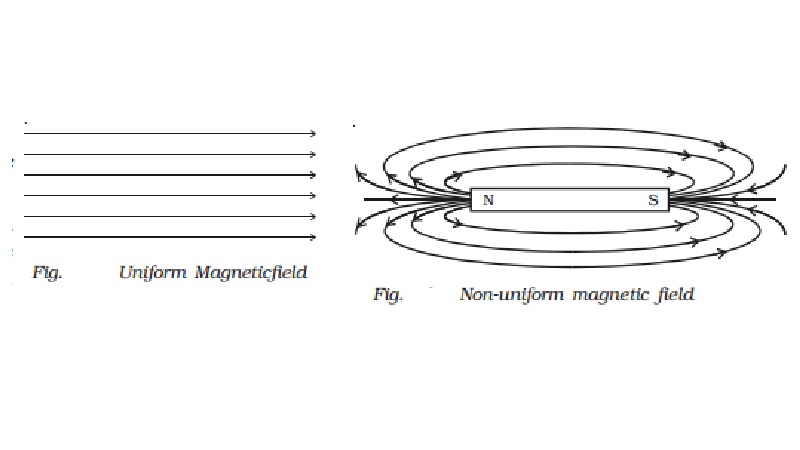Chapter: 11th 12th std standard Class Physics sciense Higher secondary school College Notes
Basic properties of magnets

Basic properties of magnets
(i)When the magnet is dipped in iron filings, they cling
to the ends of the magnet. The attraction is maximum at the two ends of the
magnet. These ends are called poles of the magnet.
(ii) When a magnet is freely
suspended, it always points along north-south direction. The pole pointing
towards geographic north is called north pole N and the pole which points towards geographic south is called
south pole S.
(iii) Magnetic poles always exist in
pairs. (i.e) isolated magnetic pole does not exist.
The magnetic length of a magnet
is always less than its geometric length, because the poles are situated a
little inwards from the free ends of the magnet. (But for the purpose of
calculation the geometric length is
always taken as magnetic length.)
(v)
Like poles repel each other and unlike poles attract each other.
North pole of a magnet when brought near north pole of another magnet, we can
observe repulsion, but when the north pole of one magnet is brought near south
pole of another magnet, we observe attraction.
(vi)The force of attraction or repulsion between two
magnetic poles is given by Coulomb?s inverse square law.
Note : In recent days, the
concept of magnetic poles has been completely changed. The origin of magnetism
is traced only due to the flow of current. But anyhow, we have retained the
conventional idea of magnetic poles in this chapter. Pole strength is denoted
by m and its unit is ampere metre.
Magnetic moment
Since any magnet has two poles,
it is also called a magnetic dipole.
The magnetic moment of a magnet is defined as the
product of the pole strength and the distance between the two poles.
If m is the pole strength of each pole and 2l is the distance between the poles, the magnetic moment
Vector M = m (2 Vector
l )
Magnetic moment is a vector
quantity. It is denoted by M. Its unit is A m2. Its direction is
from south pole to north pole.
Magnetic field
Magnetic field is the space in
which a magnetic pole experiences a force or it is the space around a magnet in
which the influence of the magnet is felt.
Magnetic induction
Magnetic induction is the
fundamental character of a magnetic field at a point.
Magnetic induction at a point in a magnetic field is
the force experienced by unit north pole placed at that point. It is denoted by B. Its unit is
N/Am . It is a vector quantity. It is also called as magnetic flux density.
If a magnetic pole of strength m
placed at a point in a magnetic field experiences a force F, the magnetic
induction at that point is
B=F/m
Magnetic lines of force
A magnetic field is better
studied by drawing as many number of magnetic lines of force as possible.
A magnetic line of force is a line along which a free
isolated north pole would travel when it is placed in the magnetic field.
Properties of magnetic lines of
force
(i)Magnetic lines of forces are closed continuous
curves, extending through the body of the magnet.
(ii) The direction of line of force is
from north pole to south pole outside the magnet while it is from south pole to
north pole inside the magnet.
(iii)
The tangent to the magnetic line of force at any point gives the
direction of magnetic field at that point. (i.e) it gives the direction of magnetic
induction (Vector B ) at that point
(iv)
They never intersect each other.
(v) They crowd where the magnetic
field is strong and thin out where the field is weak.
Magnetic flux and magnetic flux
density
The number of magnetic lines of force passing through
an area A is called magnetic flux. It is denoted by
φ . Its unit is weber. It is a scalar
quantity.
The number of magnetic lines of force crossing unit
area kept normal to the direction of line of force is magnetic flux density. Its unit is Wb m?2 or
tesla or N A?1m?1.
Magnetic flux φ = Vector B . Vector A
Uniform and non-uniform magnetic field
Magnetic field is said to be
uniform if the magnetic induction has the same magnitude and the same direction
at all the points in the region. It is represented by drawing parallel lines
(Fig.).

An example of uniform magnetic
field over a wide area is the Earth?s magnetic field.
If the magnetic induction varies
in magnitude and direction at different points in a region, the magnetic field
is said to be non-uniform. The magnetic field due to a bar magnet is
non-uniform. It is represented by convergent or divergent lines (Fig.).
Related Topics